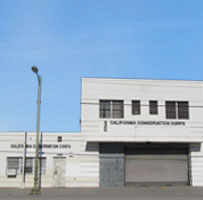Life as a Playboy
Robin Alvarez, a former member of the South Central Los Angeles Playboys gang, tells us his story of life on the streets and what ultimately made him give up his gangster lifestyle.
Relics of the post-WWII era still stand tall along Main Street - air raid sirens. Although they were originally installed to alert Angelinos of an impending air strike, they have been configured to serve as part of the statewide Emergency Alert System. During the 1992 Los Angeles riots, certain public services were stretched beyond their limits and while some eventually expanded, some were discontinued. Listen to find out how the city responds to crisis, whether it be natural disasters or urban unrest.
LACMA has a special library program where representatives go to libraries throughout Los Angeles and teach art to children and their families for free. At the Junipero Serra Library, children are taught art techniques such as drawing, painting and sculpting. However, the purpose of the program is not just to teach kids art skills; it's also about exposing the kids to culture and getting them to interact with one another.
PVJOBS on Main St. provides training and job placement for careers in construction for at-risk Angelenos. Applicants must meet certain requirements such as a history of substance abuse and have been referred from a partnered advocacy group.
By Laura Cueva
Robin Alvarez was 14 years old when he joined the infamous Playboys gang of South Central Los Angeles. He was 16 years old when he first got shot.
"We didn't do anything, we were just walking and they rolled up on us," Alvarez said, remembering the day.
Alvarez and his friend, another 16-year-old male, were heading west on 55th Street and Main, walking toward the home of Alvarez's friend when a car drove up and, after asking them where they were from, began to shoot.
"I didn't know who they were, I still don't know," Alvarez said. "I can't say for sure, but they had to be from one of our rivals."
Scenes like this are not uncommon in South Central. The area around Main Street is a hub for gang activity and many cross streets also boast their own gangs, such as 22nd, 36th and 38th streets.
When asked to list some of the Playboys' rival gangs, Alvarez said in shock "What? All of them?"
The prevalence of gangs and their negative effect on the community is not lost on Alvarez, 21, who left the Playboys three years ago after a stint in jail and who now works at Homeboy Industries, an organization dedicated to providing former gang members with job training.
"It's horrible," Alvarez said. "They provide protection, they take care of one another, you know, but some nights you still don't know if you're going to make it home alive."
In the area, the Playboys are rivaled by the BMS (Barrios Mojados), F13 (Florencia 13), HOB (Hang Out Boys), and 38th Street gangs, just to name a few.
Los Angeles Police Department Public Information Officer Karen Rayner recognizes the problem, but said the area is much improved.
"A few years ago it was much worse," Rayner said. "We still see problem areas, but it's died down quite a bit."
Community members and activists have also seen a difference.
"Years ago, when I started in 1988, gangbanging was everywhere," said Father Greg Boyle, founder of Homeboy Industries, located in Boyle Heights, east of Main Street. "There were about 8 major gangs out there killing each other and fighting over turf...Now there's maybe two major gangs still active in the area."
Though the gangs aren't as prevalent as they were years ago, Boyle said young people are still being recruited by older, more experienced gang members.
"I see young people everyday who don't have parents or positive role models, and that's exactly the type of kids gang members look to recruit," Boyle said. "So whether major gangs are in the area or not, the need to help these young people is still very strong."
Tammy De Leon, who works as a receptionist at Homeboy Industries, said she faced challenges daily growing up in South Central.
"Everyday someone from 18[th Street] would come up to me and try to sell me some dope," De Leon said. "Finally I said 'Why not?' and bought some. That's how they recruited me."
De Leon said she soon began selling marijuana and was initiated into the gang.
"It's bad for the community," De Leon said. "There are robberies and tagging and little kids think it's fun and cool to be in a gang and it's not."
Parents do what they can to keep their kids out of the gang life, but Agustin Sebastian, owner of a minimart on Main Street, knows sometimes you can only do so much.
"It's really hard," Sebastian said. "You can't watch [your children] all the time. When we arrived in this neighborhood, I quickly learned about gangs and drugs and all of that. That's not part of what I expected to find when I came to this country."
Sebastian also said he's taking precautions to ensure his market isn't targeted by gang members.
"That's why we had someone paint the Virgin Mary on the outside wall," Sebastian said. "That way [gangsters] will see that we're not involved in that and they'll leave us alone. Hopefully."
In the end, it was Alvarez's children who inspired him to leave the Playboys behind.
"I want to get an education, I want to be somebody," Alvarez said. "It would be cool if other gang members could see that and be that way, but a lot of them don't have any hope. My daughters gave me that hope."




